Papers by Lisa Overholtzer
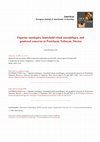
Americae, 2021
This paper explores human engagement with ceramic figurines in household ritual practice at Postc... more This paper explores human engagement with ceramic figurines in household ritual practice at Postclassic Xaltocan (Mexico). Drawing on the ontological turn, figurines are understood to be other-than-human agential entities and momentary orderings of sacred and vital energy that come into being in the context of relational ritual practice. Considering their depositional context, appearance, and three-dimensional morphology—pierced pendants, standing figures with mouths open as if mid-speech, or kneeling figures holding offering bowls—helps us understand the nature of their embodied engagement with humans. Based on ethnohistoric documents and archaeological excavation data, I argue that flat-backed Aztec figurines were lively, efficacious agents and essential parts of household ritual assemblages, helping to ensure household health and success, especially in stressful contexts such as times of war. I take an inclusive approach to gender in the household and consider the frequencies and excavation context of figurine men and women of the flat-backed type and explore interconnections between human men’s and women’s work and household concerns. This research also provides a window into shifts in household anxieties and the lived experience of men and women within the era’s rapidly changing social, political, and economic contexts. The Middle Postclassic emerges as the period defined by the most fear, uncertainty, and instability for commoner men and women at Xaltocan, more so than the Late Postclassic period, of the Aztec rule, which is often assumed to be the era of greatest household hardship.
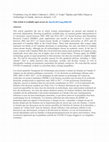
American Antiquity, 2021
This article quantifies the rate at which women archaeologists are present and retained in univer... more This article quantifies the rate at which women archaeologists are present and retained in university departments. Drawing on publicly available data, we examine gender representation in (1) doctorates earned between 2002-2003 and 2016-2017; (2) Social Sciences and Humanities Research Council (SSHRC) grant applications and awards at the doctoral to senior levels between 2003 and 2017; (3) tenure-stream faculty at Canadian universities in 2019; and (4) placement of Canadian PhDs in the United States. These data demonstrate that women today represent two-thirds of all Canadian doctorates in archaeology, but only one-third of Canadian tenure-stream faculty, although not all archaeologists choose an academic career. In the last 15 years, women with Canadian PhDs have been hired into tenure-track positions in Canada at rates statistically lower than men, but at higher rates in the United States. Women apply for SSHRC archaeology grants in equal proportion to their presence, but men are awarded at a slightly higher rate. We end by discussing the possible reasons for this gendered attrition, including a "chilly climate"-that is, subtle practices that stereotype, exclude, and devalue women, as well as inhospitable working environments, particularly for primary caregivers. We warn that the current COVID-19 pandemic is likely to exacerbate these existing inequalities.
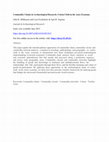
Journal of Archaeological Research , 2019
This paper applies the interdisciplinary approaches of commodity chain, commodity circuit, and c... more This paper applies the interdisciplinary approaches of commodity chain, commodity circuit, and commodity network analyses—common in sociology, anthropology, and geography—to cotton cloth in the Aztec economy to demonstrate how these techniques can enrich archaeological understandings of ancient economies. Commodity chain analysis draws attention to social and economic dependencies that link people and processes along a production sequence and across wide geographic areas. Commodity circuits and commodity networks highlight the bundling of goods and knowledge in nonlinear and multidirectional flows, the relationships that link participants through these flows, and the flexible meanings and values of goods for participants. By applying these approaches to the archaeological study of cotton cloth in the Aztec economy, we show how they provide a holistic framework for studying goods that bridges the microscale (household) and macroscale (world system).
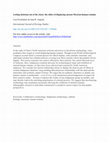
In the wake of Native North American activism and moves to decolonize archaeology, some academics... more In the wake of Native North American activism and moves to decolonize archaeology, some academics have begun to avoid displaying human remains. Though recent World Archaeological Congress accords detail a consent process for ethical display, some journals, museums, and individual scholars have blanket policies covering even those remains whose descendants favour display. This article examines one context affected by these policies: the central Mexican town of Xaltocan. Here, Indigenous residents advocate for archaeological study and exhibition of ancient human remains, yet they have been criticised and censored by North American audiences. We consider two factors behind their desire to display the dead as part of efforts to reclaim Indigenous identities: long-standing Mesoamerican relationships with the dead and the materiality and symbolic capital of bones. We argue that an academic reluctance to display any human remains is problematic – even if it is a well-intentioned acknowledgement of respect for their sensitive nature – because it imposes the wishes of one Indigenous group on another, and may thereby lead to the unwitting perpetuation of colonial practice. We suggest that decolonizing archaeology may sometimes necessitate allowing the exhibition of skeletal remains; ethnographic research in individual communities is needed to ensure respect for descendant perspectives.

In recent years, archaeologists have productively exploited historical documents and monuments as... more In recent years, archaeologists have productively exploited historical documents and monuments as evidence for social memory and the selective writing, rewriting, and silencing of history for instrumental purposes. However, for a variety of theoretical and methodological reasons, less consideration has been given to such powerful uses of the past in the past by commoners in domestic contexts. In this article,
we present a case study that demonstrates how the household remains of commoners can be used as rich, direct sources of evidence for the conscious manipulation and deployment of social memory. Our case study focuses on multiple lines of evidence from burials interred under a household patio at the pre-Aztec and Aztec site of Xaltocan between C.E. 1290 and 1520. Archaeological burial data, osteological analyses, a fine-grained chronology created with Bayesian statistical modeling of radiocarbon dates, and ancient DNA analyses are combined to reconstruct the household genealogical history inscribed by residents. This history—perhaps motivated by power and claims to land—
entailed selective remembering and forgetting and the rewriting of the past of life on this house mound and was enabled by material mnemonics in the form of buried bones. Interestingly, this inscribed, instrumental genealogical history may have been structured by some of the same principles and representational canons that shaped pre-Hispanic pictorial genealogies used as evidence in colonial legal disputes.
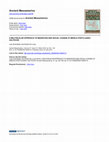
Ethnohistoric documents characterize the thirteenth and fourteenth centuries in central Mexico as... more Ethnohistoric documents characterize the thirteenth and fourteenth centuries in central Mexico as an era of endemic warfare and mass migration, processes that archaeologists have causally related to the development of the Aztec Empire. In this paper, we explore a striking transition in this dynamic, but poorly understood period at the Otomi capital of Xaltocan. The archaeological record reveals that with the adoption of Aztec II Black-on-Orange pottery by a.d. 1240, Xaltocan witnessed the expansion of the island to accommodate more residents, construction of the chinampa agricultural system, and the emergence of two subpopulations with distinct household organization, consumption, and funerary practices. We link a microscale examination of domestic activities with contextual understanding of macrolevel population dynamics, ethnic politics, and political-economic processes, and argue that this shift is due to an influx of migrants. These findings have significant implications for shifting conceptions of identity associated with the emergence of large polities.
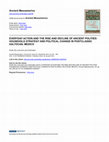
Ancient Mesoamerica, 2014
Household archaeology conducted at the site of Xaltocan, an important regional center in the nort... more Household archaeology conducted at the site of Xaltocan, an important regional center in the northern Basin of Mexico, illustrates how the everyday actions of ordinary people contribute to the rise and decline of ancient polities. Through a study of long-term change and variation from multiple household contexts, this article reconstructs how the economic and political activities of ordinary households were central to the construction and reproduction of political institutions, social structures, and regional systems of exchange from the period of Xaltocan’s founding around a.d. 900 through its conquest in a.d. 1395. Along with the other contributors to this volume we emphasize that households are not simply influenced by broader processes of change and development in a trickle-down fashion, but rather that micro- and macro-structures are mutually constituted, with household decisions and actions having both intended and unintended consequences at the macroscale.
Short post to the AAA Ethics blog
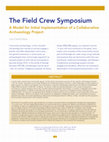
In recent years, scholars have convincingly argued, on both ethical and epistemic grounds, for th... more In recent years, scholars have convincingly argued, on both ethical and epistemic grounds, for the need for archaeological research “with, for, and by” descendant communities. Realizing such collaborative projects, however, is often challenging, and the prospect of beginning such an endeavor intimidating. This article shares a successful methodology implemented in the Xaltocan Archaeological Project (PAX) carried out in 2009–2011 in Mexico. This format—field crew-centered education in the context of excavations, culminating in a public symposium by all team members disseminating preliminary findings—is a simple, manageable way to begin engaging descendants. In addition to describing the symposium format, I discuss how I mitigated two major challenges to its implementation: (1) incentive or compensation (and, thereby, funding) and (2) community members’ critical assessments of their own
relevant knowledge. I reflect on the impact of the symposium on subsequent collaborative efforts, and I contemplate institutional obstacles that remain for scholars attempting to decolonize archaeological research in Mexico. Finally, I consider how the symposium format could be implemented in other research contexts.
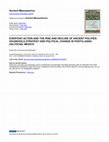
Household archaeology conducted at the site of Xaltocan, an important regional center in the nort... more Household archaeology conducted at the site of Xaltocan, an important regional center in the northern Basin of Mexico, illustrates how the everyday actions of ordinary people contribute to the rise and decline of ancient polities. Through a study of long-term change and variation from multiple household contexts, this article reconstructs how the economic and political activities of ordinary households were central to the construction and reproduction of political institutions, social structures, and regional systems of exchange from the period of Xaltocan’s founding around a.d. 900 through its conquest in a.d. 1395. Along with the other contributors to this volume we emphasize that households are not simply influenced by broader processes of change and development in a trickle-down fashion, but rather that micro- and macro-structures are mutually constituted, with household decisions and actions having both intended and unintended consequences at the macroscale.
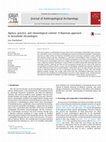
Journal of Anthropological Archaeology
This article proposes a methodological change within social archaeologies of household agency and... more This article proposes a methodological change within social archaeologies of household agency and practice, specifically a move to prioritize the development of precise household chronologies. Chronological precision can allow scholars to historicize household practice and remain anchored in social, political, and economic context, and thus, chronology is a vital part of archaeological studies of agency at the microscale. Given the field’s recent focus on detailed stratigraphic excavations, microstratigraphy, and the reconstruction of genealogies of practice, I suggest that the easiest way to improve chronological precision is Bayesian statistical modeling of a large number of stratified radiocarbon determinations from household contexts. I illustrate the value of such an approach through the case study of the Structure 122 household at Xaltocan, Mexico. I create a precise chronology using Bayesian statistical modeling of 14 AMS radiocarbon dates from stratified deposits, which allows me to not only determine the precise timing of individual deposits, but also to interrogate previous findings of ethnic shift with broader political-economic changes. This sample, while small, hints that chronological imprecision may have led to the incorrect attribution of transformations in practice to elite, imperial actors, and demonstrates how Bayesian household chronologies may help archaeologists better identify agential practices.

Journal of Archaeological Method and Theory, 2014
Neutron activation analysis (NAA) of ceramics from Xaltocan (n = 651) displays high values for so... more Neutron activation analysis (NAA) of ceramics from Xaltocan (n = 651) displays high values for sodium and potassium and low concentrations of many transition metals and rare earth elements compared to other sites in the Basin of Mexico. Given that Xaltocan was situated on an island in the middle of a saline lake, the potential reasons for this chemical signature are diverse. On one hand, if the sodium and potassium were elevated due to some behavioral aspect of the potters, the Xaltocan chemical groups provide a glimpse at the behaviors of Xaltocan potters that permit more precise source designations. On the other hand, if this chemical fingerprint arose due to contamination in a saline post-depositional environment, the Xaltocan chemical groups would not be valid references for provenance studies. To evaluate these alternative hypotheses, we employ several lines of evidence: (1) comparison of the Xaltocan ceramics to over 5,000 NAA assays of clays and ceramics from the Basin of Mexico, (2) experimental doping of clays with water of different salinities and fired to different temperatures, (3) leaching experiments of archaeological pottery sherds (n = 22) recovered from the site of Xaltocan, and (4) laser ablation–inductively coupled plasma–mass spectrometry of the clay and temper fraction of a small sample of Xaltocan ceramics to determine which component is responsible for the elevated sodium and potassium values. The results suggest that the high sodium and potassium values were present in the ceramic paste before firing. We then use these newly established reference groups to better understand the role of Xaltocan in the regional economy. The type of experimentation employed in this study has proven to be an important method for determining the behaviors of ancient potters and distinguishing them from post-depositional processes.
This article proposes a new four-phase chronology for Postclassic and colonial occupation at Xalt... more This article proposes a new four-phase chronology for Postclassic and colonial occupation at Xaltocan, Mexico, using Bayesian statistical modeling of a suite of 54 radiometric dates. Of these, 46 samples come from recent extensive excavations of sealed, stratified household deposits, facilitating improved understanding of sample context and resulting in a more accurate chronology. The timing of the adoption of major ceramic wares at the site and intrasite level is outlined and contextualized within broad, regional phases. These results are particularly valuable given recent research that repudiates a uniform chronological framework for the Basin of Mexico in the Postclassic period, and indicates instead a significant amount of chronological overlap and regional variation in the use of distinct ceramic types.
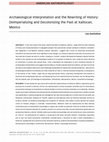
American Anthropologist, 2013
In this case study of the Aztec imperial transition at Xaltocan, Mexico, I argue that the same re... more In this case study of the Aztec imperial transition at Xaltocan, Mexico, I argue that the same rewriting of history and misrepresentation of subjugated peoples that postcolonial scholars attribute to Western colonialism also happened in non-Western imperial contexts. Moreover, I suggest that a focus on historically documented transitions has obscured other more significant social changes; our research questions have been structured by the very exercise of power we wish to counter. Drawing on Trouillot, I explore discrepancies between imperial histories written in the colonial era and archaeological evidence of occupation at Xaltocan, and I reveal the active silencing of commoners in ancient and colonial times. I then contemplate the implications of such revisionist histories for archaeological interpretation and suggest that by failing to critically evaluate historical evidence, we have incorrectly ascribed social change to elite actors and unwittingly perpetuated an imperial and colonial perspective. I also point to archaeological evidence of a dramatic pre-Aztec transition at 1240 C.E. that has remained unexplored, a consequence of the tyranny of text. Finally, I argue that by using postcolonial theory, examining contradictions and tensions in historical and archaeological data sets, and displacing focus from imperial historical narratives, we can deimperialize the pre-Hispanic past. [archaeological interpretation, ethnohistory, Mesoamerica, Mexico, household archaeology] RESUMEN En este estudio de caso acerca de la transición imperial azteca en Xaltocan, México, argumento que los procesos de re-escribir la historia y formar una representación errónea de pueblos sometidos que los historiadores poscoloniales atribuyen al colonialismo occidental también ocurrió en contextos imperiales no occidentales. Además, sugiero que nuestro enfoque en las transiciones documentadas históricamente ha oscurecido otros cambios sociales más significativos; nuestras preguntas de investigación han sido estructuradas por el mismo ejercicio de poder que deseamos contrarrestar. Basados en Trouillot, exploro las discrepancias entre las historias imperiales escritas en laépoca colonial y la evidencia arqueológica de ocupación en Xaltocan, para revelar el activo silenciar de la gente común en tiempos antiguos y coloniales. Posteriormente, reflexiono sobre las implicaciones de tales historias revisionistas para la interpretación arqueológica y sugiero que al fallar la evaluación crítica de la evidencia histórica, hemos incorrectamente atribuido los cambios sociales a los actores de laélite e inconscientemente perpetuado una perspectiva imperial y colonial. También señalo que la evidencia arqueológica de una transición pre-Azteca dramática en 1240 A.C. ha permanecido sin explorar a consecuencia del abuso del texto histórico. Finalmente, argumento que al usar una teoría poscolonial, examinando contradicciones y tensiones en base a datos arqueológicos e históricos, desplazando así la atención de las narrativas históricas, podemos desimperializar el pasado prehispánico. [interpretación arqueológica, etnohistoria, Mesoamérica, México, arqueología doméstica]

Journal of Archaeological Method and Theory, 2013
Neutron activation analysis (NAA) of ceramics from Xaltocan (n=651) displays high values for sodi... more Neutron activation analysis (NAA) of ceramics from Xaltocan (n=651) displays high values for sodium and potassium and low concentrations of many transition metals and rare earth elements compared to other sites in the Basin of Mexico. Given that Xaltocan was situated on an island in the middle of a saline lake, the potential reasons for this chemical signature are diverse. On one hand, if the sodium and potassium were elevated due to some behavioral aspect of the potters, the Xaltocan chemical groups provide a glimpse at the behaviors of Xaltocan potters that permit more precise source designations. On the other hand, if this chemical fingerprint arose due to contamination in a saline post-depositional environment, the Xaltocan chemical groups would not be valid references for provenance studies. To evaluate these alternative hypotheses, we employ several lines of evidence: (1) comparison of the Xaltocan ceramics to over 5,000 NAA assays of clays and ceramics from the Basin of Mexico, (2) experimental doping of clays with water of J Archaeol Method Theory different salinities and fired to different temperatures, (3) leaching experiments of archaeological pottery sherds (n=22) recovered from the site of Xaltocan, and (4) laser ablation-inductively coupled plasma-mass spectrometry of the clay and temper fraction of a small sample of Xaltocan ceramics to determine which component is responsible for the elevated sodium and potassium values. The results suggest that the high sodium and potassium values were present in the ceramic paste before firing. We then use these newly established reference groups to better understand the role of Xaltocan in the regional economy. The type of experimentation employed in this study has proven to be an important method for determining the behaviors of ancient potters and distinguishing them from post-depositional processes.
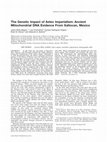
American Journal of Physical Anthropology, 2012
In AD 1428, the city-states of Tenochtitlan, Texcoco, and Tlacopan formed the Triple Alliance, la... more In AD 1428, the city-states of Tenochtitlan, Texcoco, and Tlacopan formed the Triple Alliance, laying the foundations of the Aztec empire. Although it is well documented that the Aztecs annexed numerous polities in the Basin of Mexico over the following years, the demographic consequences of this expansion remain unclear. At the city-state capital of Xaltocan, 16th century documents suggest that the site's conquest and subsequent incorporation into the Aztec empire led to a replacement of the original Otomí population, whereas archaeological evidence suggests that some of the original population may have remained at the town under Aztec rule. To help address questions about Xaltocan's demographic history during this period, we analyzed ancient DNA from 25 individuals recovered from three houses rebuilt over time and occupied between AD 1240 in Wiley Online Library (wileyonlinelibrary.com).
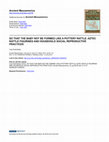
Ancient Mesoamerica, Mar 2012
This paper examines the materiality-or the mutually constitutive relationships between people and... more This paper examines the materiality-or the mutually constitutive relationships between people and things-of Aztec rattle figurines in order to shed light on household ritual life in Postclassic central Mexico. By examining iconographic, archaeological, and ethnohistoric evidence, I argue that these figurines were actively used in household healing rituals concerning successful biological and social reproduction, comprised of the work, relationships, and attitudes that perpetuate human life. I then consider the physical experience of that ritual use by exploring the visual, tactile, auditory, and physiological aspects of these figurines. I contend that their visibility in workshops, markets, and the home presented an image of the female body that reinforced women's important roles in the production and reproduction of the household and society. Finally, the material qualities of these figurines reveal ancient discourses on the human body and experimentation with bodily representation in terms of scale, form, and material.

Journal of Social Archaeology, 2011
This article proposes a way to bridge the chasm dividing archaeological studies of material prope... more This article proposes a way to bridge the chasm dividing archaeological studies of material properties and materials analyses from those of materiality, i.e. the mutually constitutive relationships between people and objects. This approach is demonstrated through the reconstruction of the life histories of curated figurines from Xaltocan, Mexico. Critical to this inquiry is an understanding of the material properties of the figurines -including form, style, and fragmentation -as well as materials analysis, specifically neutron activation analysis, which offers evidence of their places of origin. Using a life history approach provides insight into the production of Xaltocan as a place and its residents as people enchained or linked to ancient Teotihuacan, through the movement of these figurines through space and time. Furthermore, it demonstrates that these figurines, often ignored as accidents of site formation processes, were actually a crucial form of material culture through which residents constructed relationships with the past.
In: Mesoamerica Figurines, C.T. Haplerin, K.A. Fauste, R. Taube, and A. Giguet, eds., p. 297-323. Gainesville: University Press of Florida., 2009

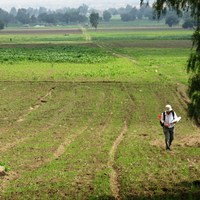


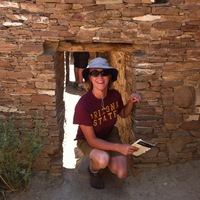
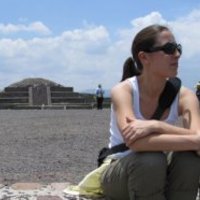
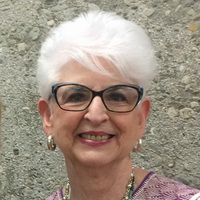
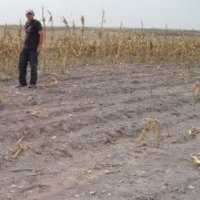


Uploads
Papers by Lisa Overholtzer
we present a case study that demonstrates how the household remains of commoners can be used as rich, direct sources of evidence for the conscious manipulation and deployment of social memory. Our case study focuses on multiple lines of evidence from burials interred under a household patio at the pre-Aztec and Aztec site of Xaltocan between C.E. 1290 and 1520. Archaeological burial data, osteological analyses, a fine-grained chronology created with Bayesian statistical modeling of radiocarbon dates, and ancient DNA analyses are combined to reconstruct the household genealogical history inscribed by residents. This history—perhaps motivated by power and claims to land—
entailed selective remembering and forgetting and the rewriting of the past of life on this house mound and was enabled by material mnemonics in the form of buried bones. Interestingly, this inscribed, instrumental genealogical history may have been structured by some of the same principles and representational canons that shaped pre-Hispanic pictorial genealogies used as evidence in colonial legal disputes.
relevant knowledge. I reflect on the impact of the symposium on subsequent collaborative efforts, and I contemplate institutional obstacles that remain for scholars attempting to decolonize archaeological research in Mexico. Finally, I consider how the symposium format could be implemented in other research contexts.
we present a case study that demonstrates how the household remains of commoners can be used as rich, direct sources of evidence for the conscious manipulation and deployment of social memory. Our case study focuses on multiple lines of evidence from burials interred under a household patio at the pre-Aztec and Aztec site of Xaltocan between C.E. 1290 and 1520. Archaeological burial data, osteological analyses, a fine-grained chronology created with Bayesian statistical modeling of radiocarbon dates, and ancient DNA analyses are combined to reconstruct the household genealogical history inscribed by residents. This history—perhaps motivated by power and claims to land—
entailed selective remembering and forgetting and the rewriting of the past of life on this house mound and was enabled by material mnemonics in the form of buried bones. Interestingly, this inscribed, instrumental genealogical history may have been structured by some of the same principles and representational canons that shaped pre-Hispanic pictorial genealogies used as evidence in colonial legal disputes.
relevant knowledge. I reflect on the impact of the symposium on subsequent collaborative efforts, and I contemplate institutional obstacles that remain for scholars attempting to decolonize archaeological research in Mexico. Finally, I consider how the symposium format could be implemented in other research contexts.
DOI: 10.1111/apaa.12057
Report submitted to INAH, June 2009. Offers description of survey and excavation of chinampas, results of archaeobotanical analysis, results of oseteological analysis, figurine analysis, and description of other sites. Historically, provides archaeological data from the Epiclassic period to the Colonial period.